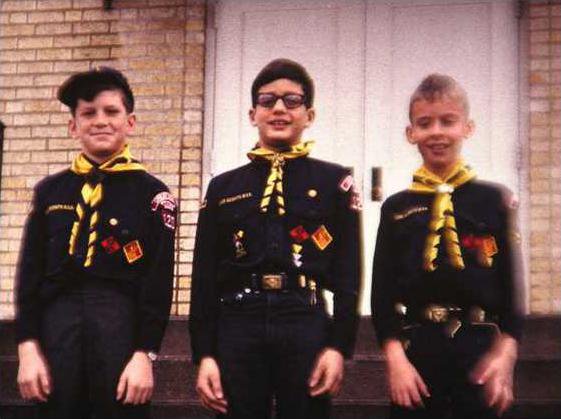Anyone over the age of 45 remembers the network soap opera “Dark Shadows.” In the 1960s, it was carried on ABC and that was one network signal our TV could receive in the middle of nowhere. And my brothers and sisters were hooked on it. Our television diet then was “Batman,” “Perry Mason” and “Dark Shadows.” Barnabas Collins, a vampire, flashed his fangs and was always searching for fresh blood. He was the spookiest thing we had ever seen. And blood became something of a fixation for us.
A couple years later Darren McGavin starred in another vampire show — “The Night Stalker.” Also super creepy and it further ingrained our fascination with blood, life and death.
Our dad unwittingly contributed to this. From time to time over the dinner table mom would say, “The hospital called and asked your dad to come down. They needed his blood.” My brothers and I would exchange glances. “They needed dad’s blood! That is so cool!” Dad, it turns out, is O negative. A universal donor — which is precisely the type craved by vampires. And, I suppose, patients in the ER.
Right about this time, Truman Capote entered the world stage with “In Cold Blood.” It would be only a modest exaggeration to say that the Clutter family killing and Capote’s later work changed everything, but particularly in small-town America. And most certainly small-town Kansas. In fact, convicted killers Richard Hickock and Perry Smith stopped in Great Bend en route to Holcomb on that fateful night. And the movie is faithful to this — the A&W scene was filmed just two miles from our house.
And in the middle of this teenage obsession came Scouting. And yes, the blood line continued. For example, this was our first introduction to ticks. It was May 1972, and a young Scout discovered one on his scalp. One of the adult leaders gathered us around. “Boys, this is a tick.” We all grew close to the kid’s head. The critter was bulging. “See, it’s full of blood! Ticks wait on trees for years and years until an unsuspecting Tenderfoot walks by. Then they strike and start sucking your blood.”
Most everyone was terrified. Not me. I knew all about that five-letter word. The leader then fired up a match to burn it out, singeing gobs of hair and likely inflicting second-degree burns in the process. Today any adult attempting such a thing would be in Leavenworth.
There were other things. We learned how apply a tourniquet — sacrificing a limb to save a life. We experimented with rubber bands during religion class. Turning your finger purple while Sister Mary Rose lectured us on the Holy Trinity was essential to becoming an Eagle Scout.
But the pot of gold was the opportunity to acquire a pocketknife. Knives were the stuff of Daniel Boone, The Lone Ranger and adult movies we could never watch. With a pocket knife, a switchblade wasn’t far away. And then you could be a blood brother — cutting your finger and mixing your blood with your friend. This was the coolest of all cools.
But to get a knife you first needed to demonstrate knife safety. This determination rested entirely in the hands of the Senior Patrol Leader, a.k.a. the SPL. When you are 11, the SPL knew everything. He did everything. The SPL was typically a Life Scout, which to a Tenderfoot was like a five-star general. He had a girlfriend, sideburns and absentee parents. Our SPL drank coffee, put mustard on his hotdogs and told outrageous stories. He was a man. In truth, he was maybe 15. But he had a knife, a hatchet and knew how to acquire a switchblade.
Part of the training required learning something called the “blood circle.” This is an exercise involving swinging the knife in a circle around you to ensure no one is close enough to be harmed. In theory when executed, the blade is supposed to be closed. In reality it was always fully extended and accompanied with a loud declaration: “my blood circle!” This was the Shangri-La of Scouting — to be allowed to wave your knife among your peers while using the B word.
You now had power to defend yourself against a grizzly, copperhead, or if necessary, your older brother or sister should they get out of line. You were also instructed to never, ever, cut down any living plant or tree. So of course that’s exactly what we did.
To prove your safety ethic, they awarded you something called a Totin’ Chip badge. You carried it in your pocket. It was the most important thing you ever owned.
As you might have gathered, the kids in our troop would never be confused with a Mensa convention. Like the cast in the movie “Sandlot,” we had buck teeth, bad hair, clunky shoes whose strings were never tied. Everything worn was hand-me-downs from our older brothers except for the Scout uniform. That was yours. It had your badges, your awards and your patrol name. And your scarf, which you hated because it choked and constrained you, especially when carving that green branch into a spear.
We threw the knives in the dirt, against trees, into the air. But if caught doing any of these things, the SPL made you surrender the Totin’ Chip, which meant, like the movie “Branded,” he took your knife. Life had no greater humiliation. To be knifeless was like a gelding.
Shockingly through all this, no one died. But every single Scout got defrocked. Over and over again.
There will be blood: Dark Shadows, pocket knives and boy scouts




